Fabrication, Characterization and Drainage Capacity of Single-Channel Porous Alumina Ceramic Membrane Tube
Abstract
:1. Introduction
2. Preparation and Characterization
2.1. Preparation of Al2O3 Porous Ceramic Membrane Tube
2.2. Characterization
2.3. Modeling Configuration and Grid Meshing
3. Results and Discussion
3.1. Phase Structure and Microstructure
3.2. Porosity and Density of Ceramic Membrane Tubes
3.3. Simulation Analysis of Water Filtering
3.3.1. Comparison of Flow Pressure and Velocity Distribution under Different Porosity
3.3.2. Pressure, Flow Field, and Velocity Distribution in the Fluid Domain Model
3.4. Experimental Verification of Water Filtering
4. Conclusions
Author Contributions
Funding
Institutional Review Board Statement
Informed Consent Statement
Data Availability Statement
Conflicts of Interest
References
- Asif, M.B.; Zhang, Z. Ceramic membrane technology for water and wastewater treatment: A critical review of performance, full-scale applications, membrane fouling and prospects. Chem. Eng. J. 2021, 418, 129481. [Google Scholar] [CrossRef]
- Zhao, Y.Y.; Wang, X.M.; Yang, H.W.; Xie, Y.-F.F. Effects of organic fouling and cleaning on the retention of pharmaceutically active compounds by ceramic nanofiltration membranes. J. Membr. Sci. 2018, 563, 734–742. [Google Scholar] [CrossRef]
- Arumugham, T.; Kaleekkal, N.J.; Gopal, S.; Nambikkattu, J.; Rambabu, K.; Aboulella, A.M.; Ranil Wickramasinghe, S.; Banat, F. Recent developments in porous ceramic membranes for wastewater treatment and desalination: A review. J. Environ. Manag. 2021, 293, 112925. [Google Scholar] [CrossRef] [PubMed]
- Wang, L.; An, L.; Zhao, J.; Shimai, S.; Mao, X.; Zhang, J.; Liu, J.; Wang, S. High-strength porous alumina ceramics prepared from stable wet foams. J. Adv. Ceram. 2021, 10, 852–859. [Google Scholar] [CrossRef]
- Fan, W.; Zou, D.; Xu, J.; Chen, X.; Qiu, M.; Fan, Y. Enhanced performance of fly ash-based supports for low-cost ceramic membranes with the addition of bauxite. Membranes 2021, 11, 711. [Google Scholar] [CrossRef]
- Padaki, M.; Surya Murali, R.; Abdullah, M.S.; Misdan, N.; Moslehyani, A.; Kassim, M.A.; Hilal, N.; Ismail, A.F. Membrane technology enhancement in oil-water separation. A review. Desalination 2015, 357, 197–207. [Google Scholar] [CrossRef]
- Mu, H.; Qiu, Q.; Cheng, R.; Qiu, L.; Xie, K.; Gao, M.; Liu, G. Adsorption-enhanced ceramic membrane filtration using fenton oxidation for advanced treatment of refinery wastewater: Treatment efficiency and membrane-fouling control. Membranes 2021, 11, 651. [Google Scholar] [CrossRef]
- Liang, D.; Huang, J.; Zhang, H.; Fu, H.; Zhang, Y.; Chen, H. Influencing factors on the performance of tubular ceramic membrane supports prepared by extrusion. Ceram. Int. 2021, 47, 10464–10477. [Google Scholar] [CrossRef]
- Boulkrinat, A.; Bouzerara, F.; Harabi, A.; Harrouche, K.; Stelitano, S.; Russo, F.; Galiano, F.; Figoli, A. Synthesis and characterization of ultrafiltration ceramic membranes used in the separation of macromolecular proteins. J. Eur. Ceram. Soc. 2020, 40, 5967–5973. [Google Scholar] [CrossRef]
- Song, X.; Jian, B.; Jin, J. Preparation of porous ceramic membrane for gas-solid separation. Ceram. Int. 2018, 44, 20361–20366. [Google Scholar] [CrossRef]
- Zou, D.; Qiu, M.; Chen, X.; Fan, Y. One-step preparation of high-performance bilayer α-alumina ultrafiltration membranes via co-sintering process. J. Membr. Sci. 2017, 524, 141–150. [Google Scholar] [CrossRef]
- Qin, H.; Guo, W.; Gao, P.; Xiao, H. Customization of ZrO2 loose/tight bilayer ultrafiltration membranes by reverse micelles-mediated aqueous sol-gel process for wastewater treatment. J. Eur. Ceram. Soc. 2021, 41, 2724–2733. [Google Scholar] [CrossRef]
- Wang, F.; Yin, J.; Yao, D.; Xia, Y.; Zuo, K.; Xu, J.; Zeng, Y. Fabrication of porous SiC ceramics through a modified gelcasting and solid state sintering. Mater. Sci. Eng. 2016, 654, 292–297. [Google Scholar] [CrossRef]
- Mestre, S.; Gozalbo, A.; Lorente-Ayza, M.M.; Sánchez, E. Low-cost ceramic membranes: A research opportunity for industrial application. J. Eur. Ceram. Soc. 2019, 39, 3392–3407. [Google Scholar] [CrossRef]
- Li, Y.; Yang, X.; Liu, D.; Chen, J.; Zhang, D.; Wu, Z. Permeability of the porous Al2O3 ceramic with bimodal pore size distribution. Ceram. Int. 2019, 45, 5952–5957. [Google Scholar] [CrossRef]
- Qin, H.; Guo, W.; Gao, P.; Xiao, H. Spheroidization of low-cost alumina powders for the preparation of high-flux flat-sheet ceramic membranes. Ceram. Int. 2020, 46, 13189–13197. [Google Scholar] [CrossRef]
- Das, D.; Kayal, N. Permeability and dust filtration behaviour of porous SiC ceramic candle filter. Mater. Today 2021, 39, 1235–1240. [Google Scholar] [CrossRef]
- Liu, J.; Ren, B.; Liu, K.; Yu, M.; Li, X.; Wang, Z.; Wang, L.; Yang, J.; Huang, Y. Highly porous SiC cellular ceramics for efficient high-temperature PM removal. Ceram. Int. 2020, 46, 15249–15254. [Google Scholar] [CrossRef]
- Rashad, M.; Sabu, U.; Logesh, G.; Balasubramanian, M. Development of porous mullite and mullite-Al2O3 composite for microfiltration membrane applications. Sep. Purif. Technol. 2019, 219, 74–81. [Google Scholar] [CrossRef]
- Rezaee, S.; Ranjbar, K.; Kiasat, A.R. Characterization and strengthening of porous alumina-20 wt% zirconia ceramic composites. Ceram. Int. 2020, 46, 893–902. [Google Scholar] [CrossRef]
- Qin, H.; Guo, W.; Xiao, H. Preparation of γ-Al2O3 membranes for ultrafiltration by reverse micelles-mediated sol-gel process. Ceram. Int. 2019, 45, 22783–22792. [Google Scholar] [CrossRef]
- Li, L.; Chen, M.; Dong, Y.; Dong, X.; Cerneaux, S.; Hampshire, S.; Cao, J.; Zhu, L.; Zhu, Z.; Liu, J. A low-cost alumina-mullite composite hollow fiber ceramic membrane fabricated via phase-inversion and sintering method. J. Eur. Ceram. Soc. 2016, 36, 2057–2066. [Google Scholar] [CrossRef]
- Wang, F.; Hao, S.; Dong, B.; Ke, N.; Khan, N.Z.; Hao, L.; Yin, L.; Xu, X.; Agathopoulos, S. Porous-foam mullite-bonded SiC-ceramic membranes for high-efficiency high-temperature particulate matter capture. J. Alloys Compd. 2022, 893, 162231. [Google Scholar] [CrossRef]
- Liu, D.; Li, Y.; Lv, C.; Chen, J.; Zhang, D.; Wu, Z.; Ding, D.; Xiao, G. Permeating behaviour of porous SiC ceramics fabricated with different SiC particle sizes. Ceram. Int. 2021, 47, 5610–5616. [Google Scholar] [CrossRef]
- Jiang, Q.; Xie, Y.; Ji, L.; Zhong, Z.; Xing, W. Low-temperature sintering of a porous SiC ceramic filter using water glass and zirconia as sintering aids. Ceram. Int. 2021, 47, 26125–26133. [Google Scholar] [CrossRef]
- Huang, L.; Qin, H.; Hu, T.; Xie, J.; Guo, W.; Gao, P.; Xiao, H. Fabrication of high permeability SiC ceramic membrane with gradient pore structure by one-step freeze-casting process. Ceram. Int. 2021, 47, 17597–17605. [Google Scholar] [CrossRef]
- Oliveira Neto, G.L.; Oliveira, N.G.N.; Delgado, J.; Nascimento, L.P.C.; Magalhaes, H.L.F.; Oliveira, P.L.; Gomez, R.S.; Farias Neto, S.R.; Lima, A.G.B. Hydrodynamic and Performance Evaluation of a Porous Ceramic Membrane Module Used on the Water-Oil Separation Process: An Investigation by CFD. Membranes 2021, 11, 121. [Google Scholar] [CrossRef]
- Tang, T.; Fu, W.; Zhang, X. Numerical simulation of fluid flow and desalination effects in ceramic membrane channels. Desalination 2021, 519, 115304. [Google Scholar] [CrossRef]
- Liu, K.; Zhao, Y.; Jia, L.; Hao, R.; Fu, D. A novel CFD-based method for predicting pressure drop and dust cake distribution of ceramic filter during filtration process at macro-scale. Powder Technol. 2019, 353, 27–40. [Google Scholar] [CrossRef]
- Li, W.L.; Ouyang, Y.; Gao, X.Y.; Wang, C.Y.; Shao, L.; Xiang, Y. CFD analysis of gas-liquid flow characteristics in a microporous tube-in-tube microchannel reactor. Comput. Fluids 2018, 170, 13–23. [Google Scholar] [CrossRef]
- Yue, C.; Zhang, Q.; Zhai, Z. Numerical simulation of the filtration process in fibrous filters using CFD-DEM method. J. Aerosol Sci. 2016, 101, 174–187. [Google Scholar] [CrossRef]
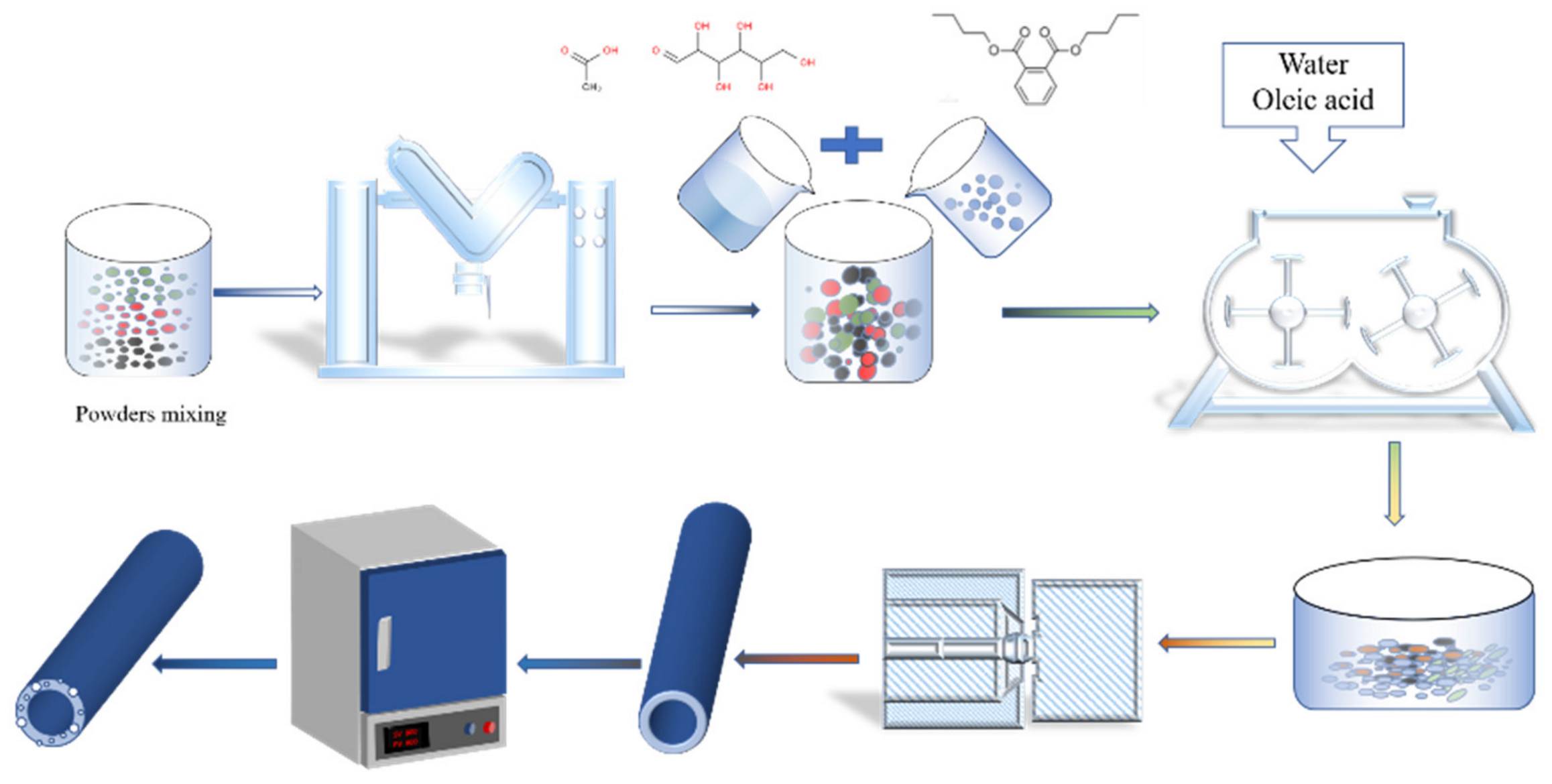
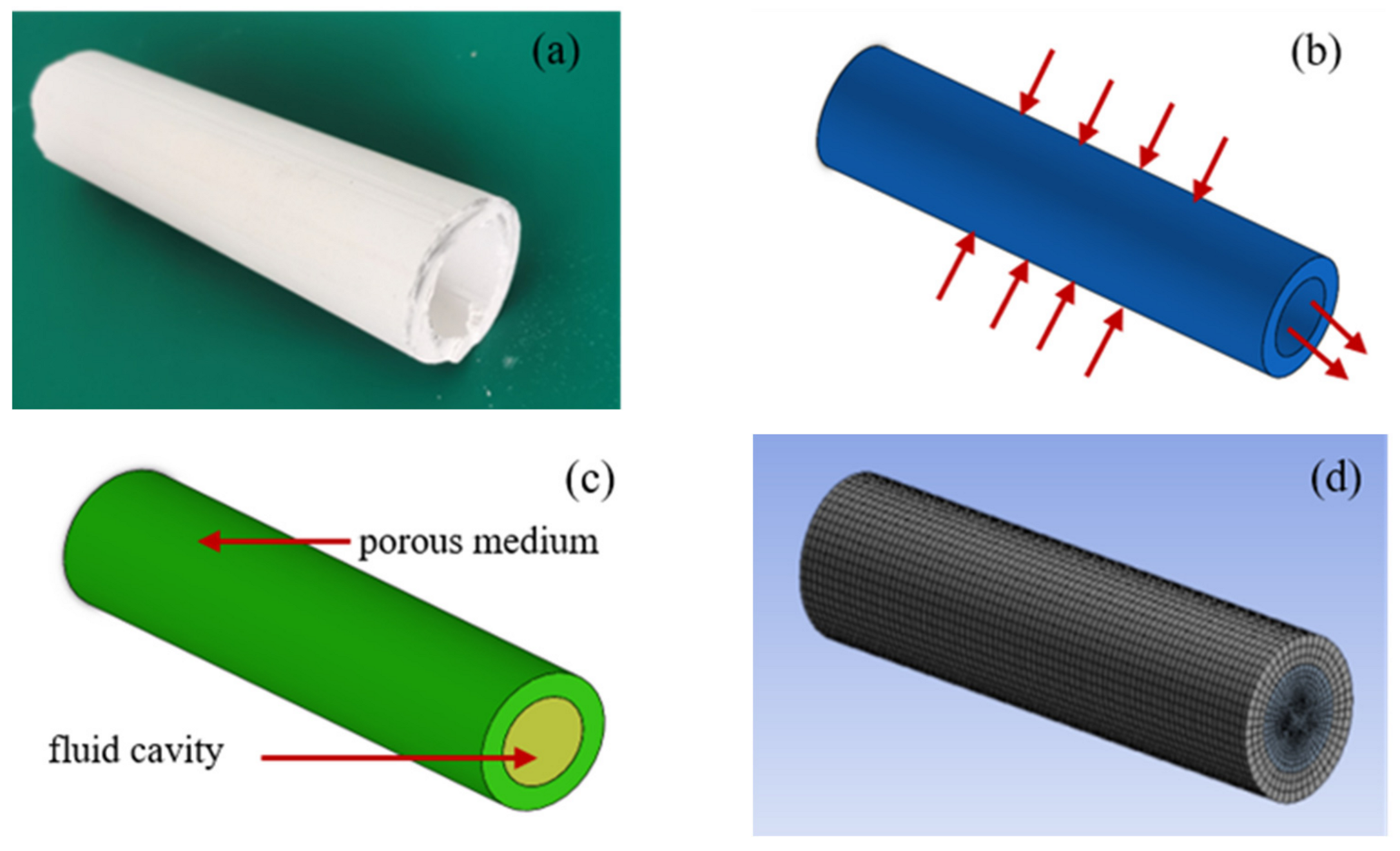
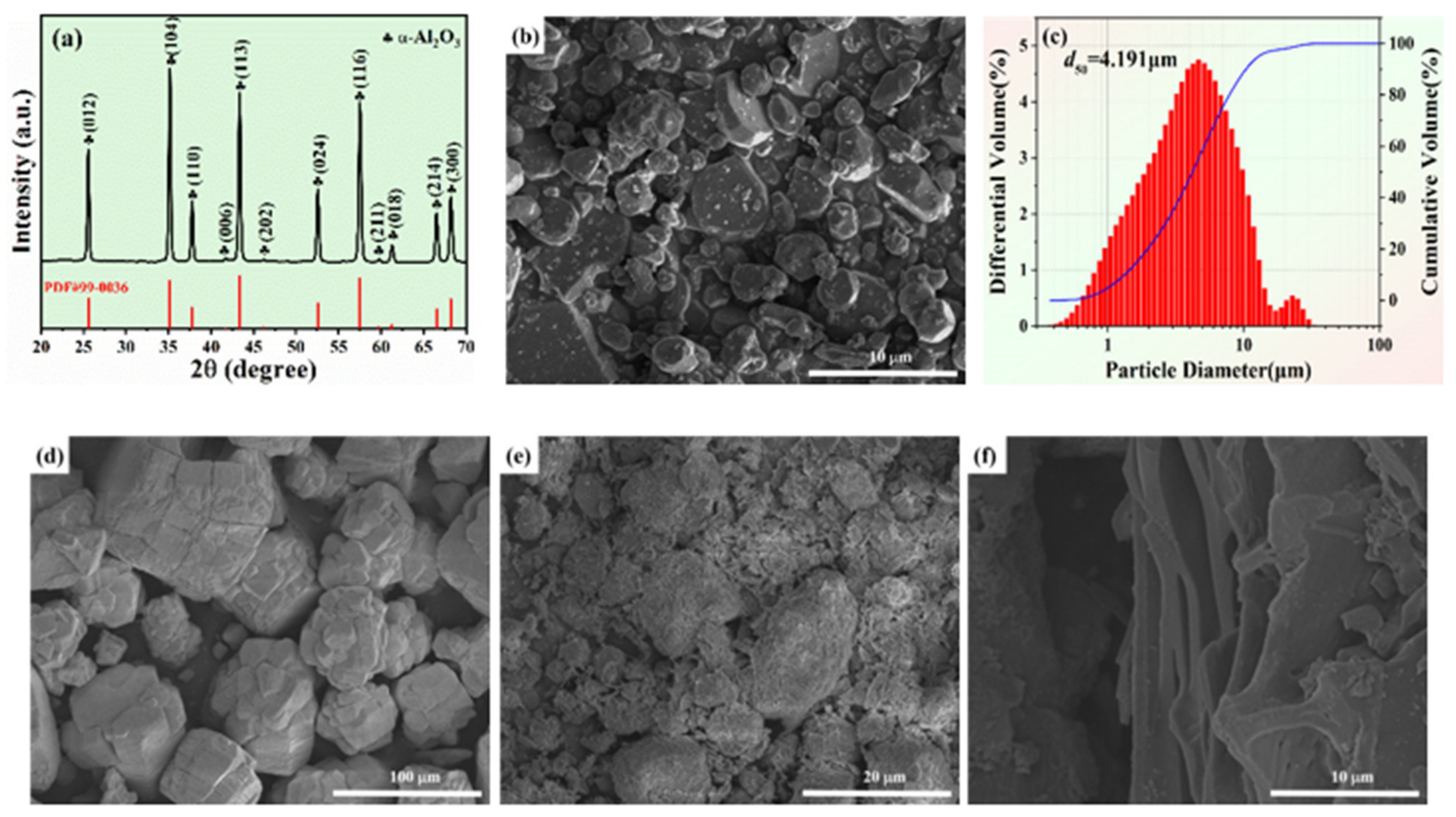
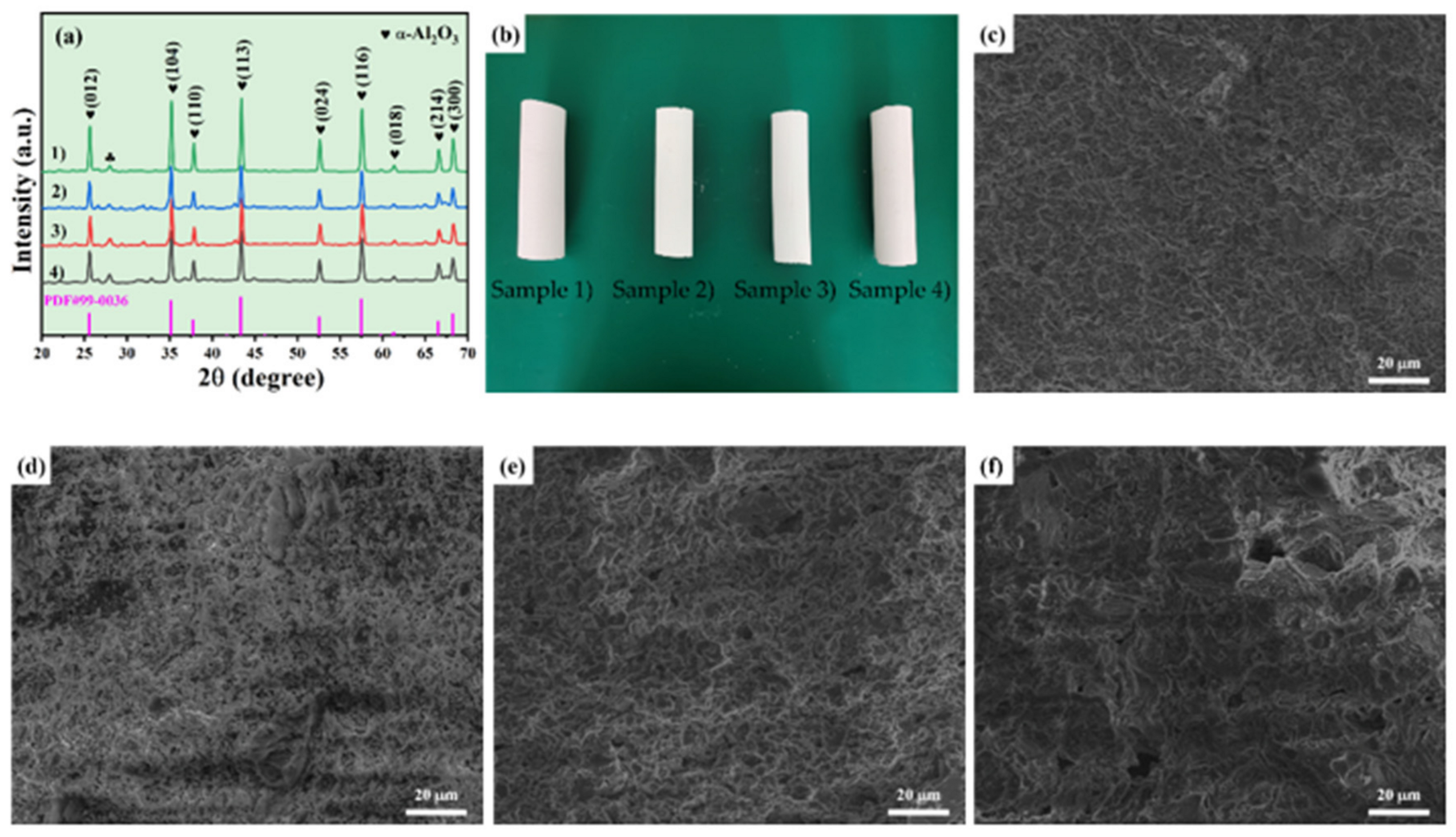

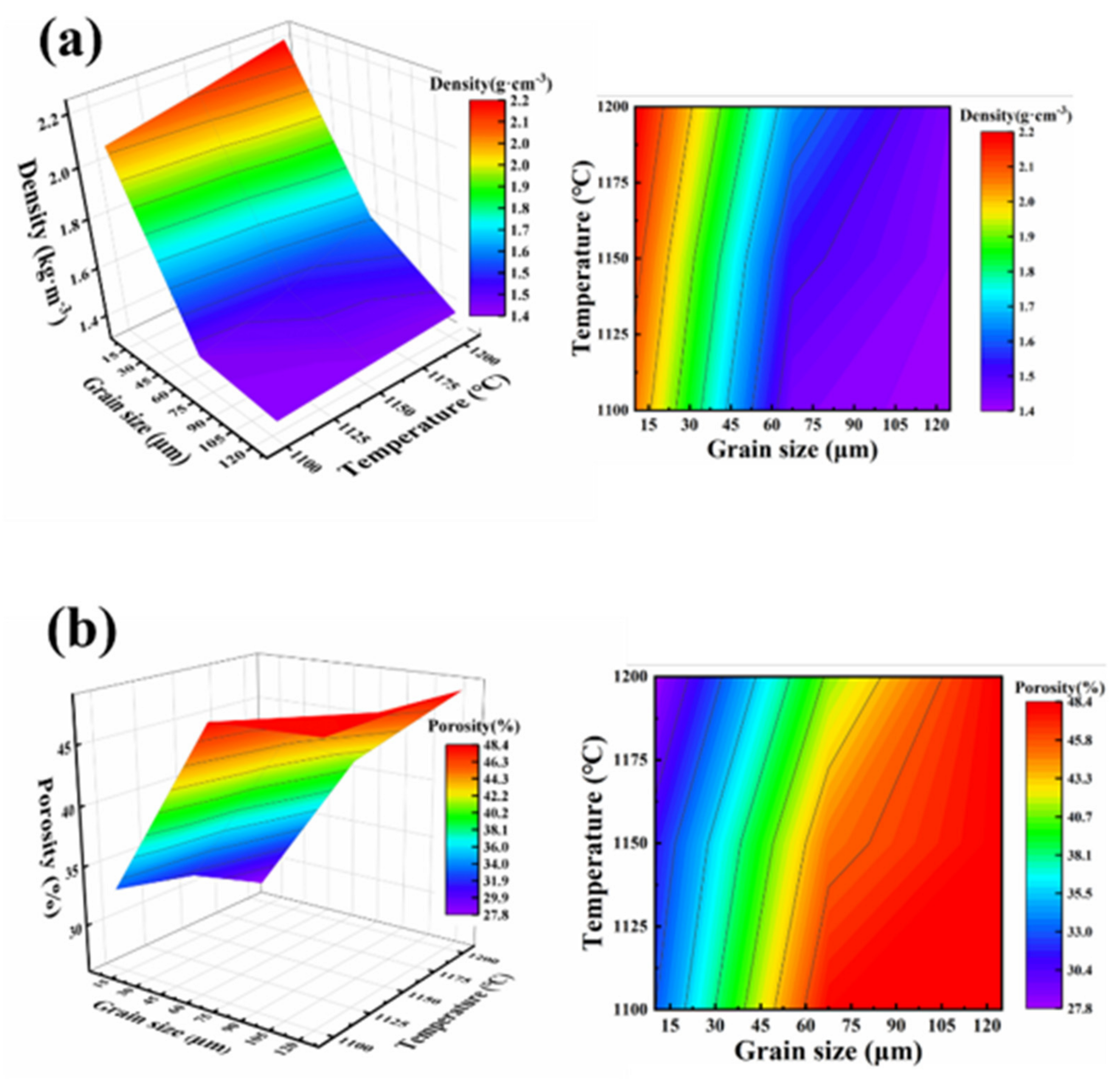
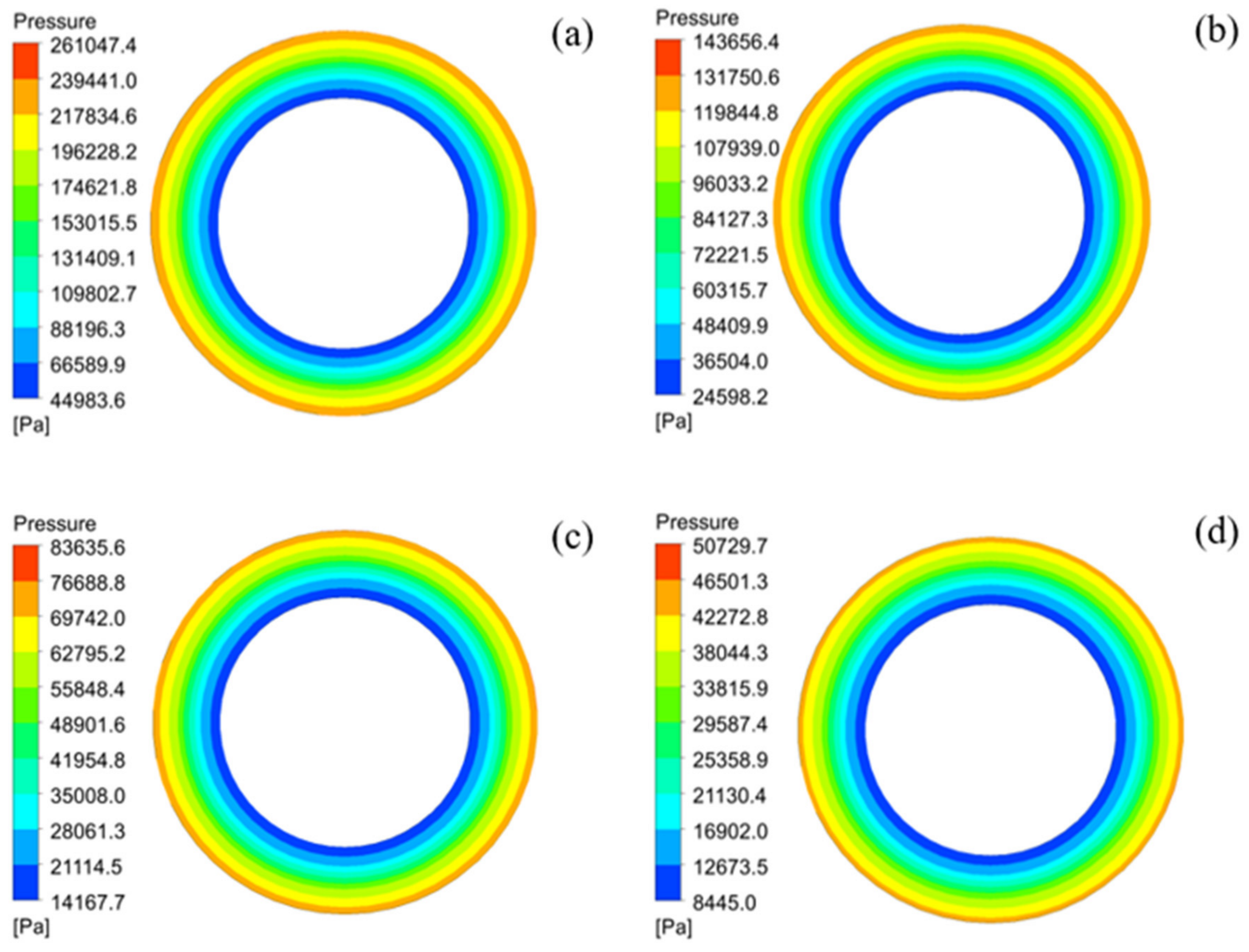
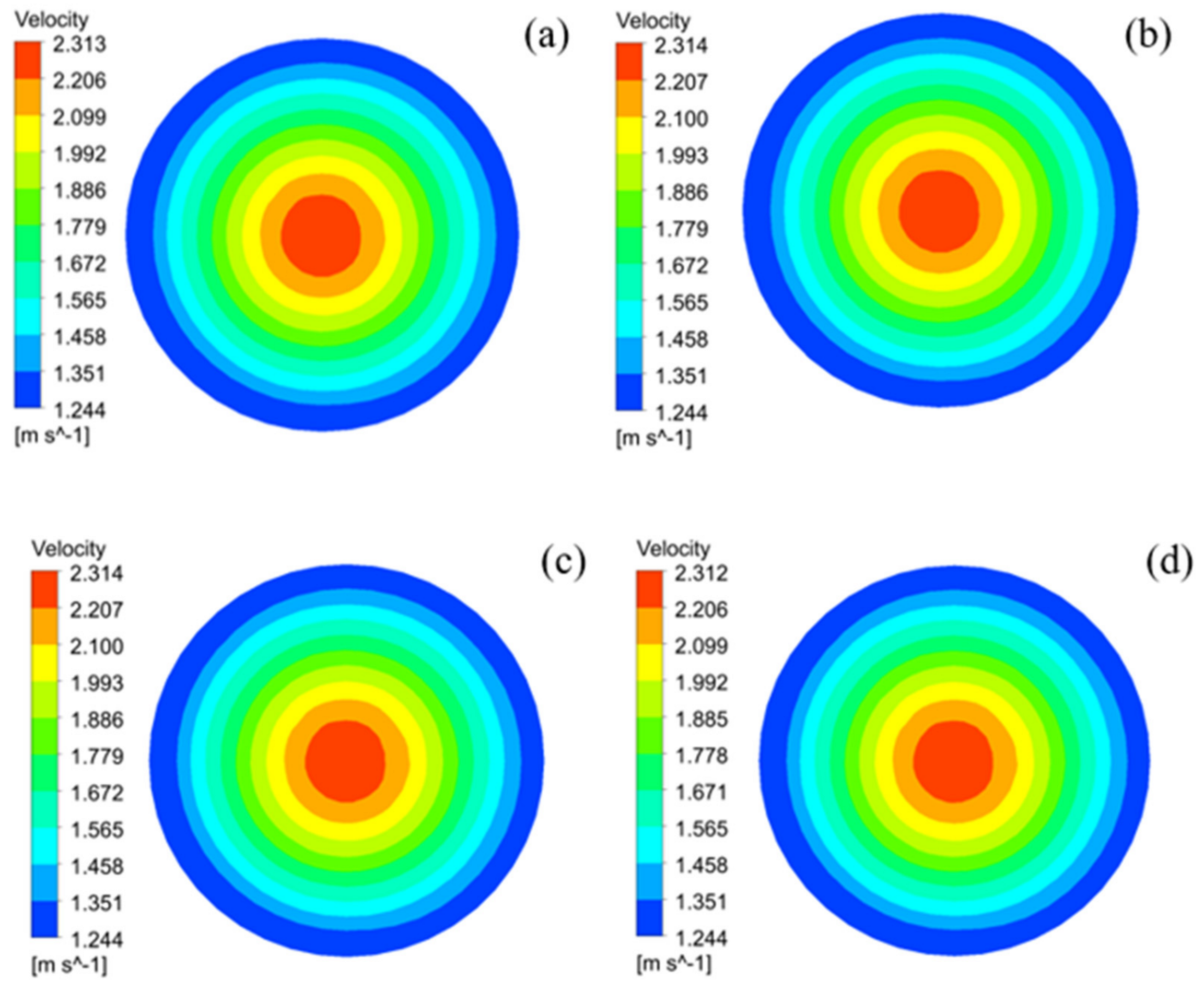
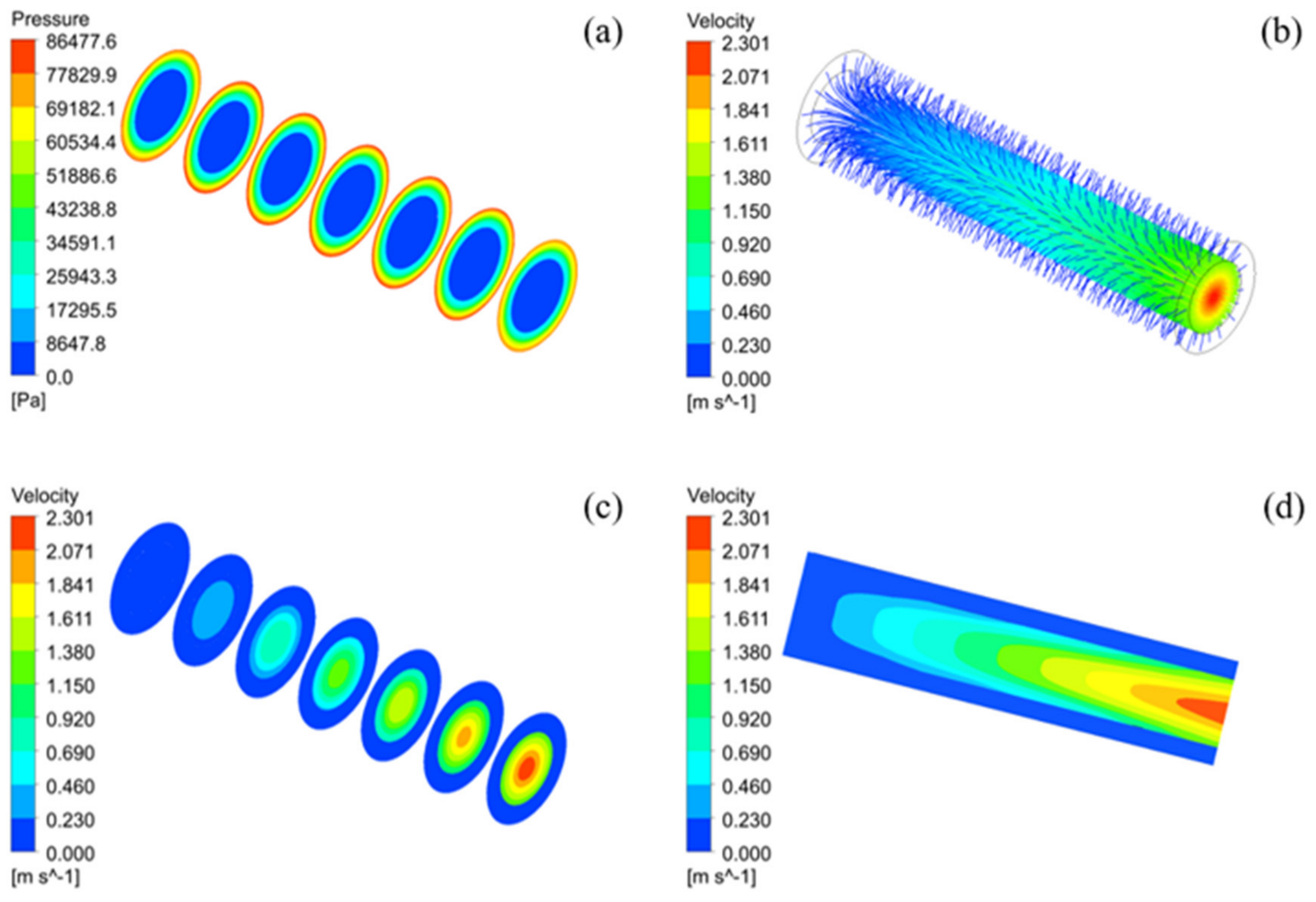

Publisher’s Note: MDPI stays neutral with regard to jurisdictional claims in published maps and institutional affiliations. |
© 2022 by the authors. Licensee MDPI, Basel, Switzerland. This article is an open access article distributed under the terms and conditions of the Creative Commons Attribution (CC BY) license (https://creativecommons.org/licenses/by/4.0/).
Share and Cite
Du, J.; Xiao, X.; Ai, D.; Liu, J.; Qiu, L.; Chen, Y.; Zhu, K.; Wang, L. Fabrication, Characterization and Drainage Capacity of Single-Channel Porous Alumina Ceramic Membrane Tube. Membranes 2022, 12, 390. https://doi.org/10.3390/membranes12040390
Du J, Xiao X, Ai D, Liu J, Qiu L, Chen Y, Zhu K, Wang L. Fabrication, Characterization and Drainage Capacity of Single-Channel Porous Alumina Ceramic Membrane Tube. Membranes. 2022; 12(4):390. https://doi.org/10.3390/membranes12040390
Chicago/Turabian StyleDu, Jianzhou, Xin Xiao, Duomei Ai, Jingjin Liu, Long Qiu, Yuansheng Chen, Kongjun Zhu, and Luming Wang. 2022. "Fabrication, Characterization and Drainage Capacity of Single-Channel Porous Alumina Ceramic Membrane Tube" Membranes 12, no. 4: 390. https://doi.org/10.3390/membranes12040390
APA StyleDu, J., Xiao, X., Ai, D., Liu, J., Qiu, L., Chen, Y., Zhu, K., & Wang, L. (2022). Fabrication, Characterization and Drainage Capacity of Single-Channel Porous Alumina Ceramic Membrane Tube. Membranes, 12(4), 390. https://doi.org/10.3390/membranes12040390











